Improving the Accuracy of TOF LiDAR Based on Balanced Detection Method
Abstract
1. Introduction
2. Methods
3. Experiment and Results
3.1. Suppressing the Effect of Background Noise
3.2. Responsivity
3.3. Improvement on Jitter Error and Walk Error
4. Conclusions
Author Contributions
Funding
Institutional Review Board Statement
Informed Consent Statement
Data Availability Statement
Acknowledgments
Conflicts of Interest
References
- Ruotsalainen, T.; Palojarvi, P.; Kostamovaara, J. A wide dynamic range receiver channel for a pulsed time-of-flight laser radar. IEEE J. Solid-State Circuits 2001, 36, 1228–1238. [Google Scholar] [CrossRef]
- Mallet, C.; Bretar, F. Full-waveform topographic lidar: State-of-the-art. ISPRS J. Photogramm. Remote Sens. 2009, 64, 1–16. [Google Scholar] [CrossRef]
- Rieger, P.; Ullrich, A. Resolving range ambiguities in high-repetition rate airborne light detection and ranging applications. J. Appl. Remote Sens. 2012, 6, 063552. [Google Scholar]
- Donati, S. Electro-Optical Instrumentation: Sensing and Measuring with Lasers; Pearson Education: London, UK, 2004. [Google Scholar]
- Areann, M.-C.; Bosch, T.; Lescure, M. Laser ranging: A critical review of usual techniques for distance measurement. Opt. Eng 2001, 40, 10–19. [Google Scholar]
- Royo, S.; Ballesta-Garcia, M. An overview of lidar imaging systems for autonomous vehicles. Appl. Sci. 2019, 9, 4093. [Google Scholar] [CrossRef]
- Geng, D.; Fu, X.; Du, P.; Wang, W.; Gong, M. Combination of differential discrimination and direct discrimination in pulsed laser time-of-flight systems. Chin. Opt. Lett. 2016, 14, 062801. [Google Scholar] [CrossRef]
- Baharmast, A.; Kostamovaara, J. Noise considerations in pulse-shaping based TIA channel designed for a pulsed TOF laser radar receiver. In Proceedings of the 2018 IEEE Nordic Circuits and Systems Conference (NORCAS): NORCHIP and International Symposium of System-on-Chip (SoC), Tallinn, Estonia, 30–31 October 2018; pp. 1–6. [Google Scholar]
- Palojarvi, P.; Ruotsalainen, T.; Kostamovaara, J. A 250-MHz BiCMOS receiver channel with leading edge timing discriminator for a pulsed time-of-flight laser rangefinder. IEEE J. Solid-State Circuits 2005, 40, 1341–1349. [Google Scholar] [CrossRef]
- Pehkonen, J.; Palojarvi, P.; Kostamovaara, J. Receiver channel with resonance-based timing detection for a laser range finder. IEEE Trans. Circuits Syst. I Regul. Pap. 2006, 53, 569–577. [Google Scholar] [CrossRef]
- Kilpelä, A.; Ylitalo, J.; Määttä, K.; Kostamovaara, J. Timing discriminator for pulsed time-of-flight laser rangefinding measurements. Rev. Sci. Instrum. 1998, 69, 1978–1984. [Google Scholar] [CrossRef]
- Li, C.; Chen, Q.; Gu, G.; Qian, W. Laser time-of-flight measurement based on time-delay estimation and fitting correction. Opt. Eng. 2013, 52, 076105. [Google Scholar] [CrossRef]
- Zhang, Z.; Zhao, Y.; Zhang, Y.; Wu, L.; Su, J. A real-time noise filtering strategy for photon counting 3D imaging lidar. Opt. Express 2013, 21, 9247–9254. [Google Scholar] [CrossRef] [PubMed]
- Kurtti, S.; Jansson, J.-P.; Kostamovaara, J. A CMOS receiver–TDC chip set for accurate pulsed TOF laser ranging. IEEE Trans. Instrum. Meas. 2019, 69, 2208–2217. [Google Scholar] [CrossRef]
- Wang, X.; Ma, R.; Li, D.; Zheng, H.; Liu, M.; Zhu, Z. A low walk error analog front-end circuit with intensity compensation for direct ToF LiDAR. IEEE Trans. Circuits Syst. I Regul. Pap. 2020, 67, 4309–4321. [Google Scholar] [CrossRef]
- Baharmast, A.; Kostamovaara, J.T. High-speed wide dynamic range linear mode time-of-flight receiver based on zero-crossing timing detection. Opt. Eng. 2020, 59, 104102. [Google Scholar] [CrossRef]
- Kostamovaara, J.T.; Maatta, K.E.; Myllylae, R.A. Pulsed time-of-flight laser range-finding techniques for industrial applications. In Proceedings of the Optics, Illumination, and Image Sensing for Machine Vision VI, Boston, MA, USA, 14–15 November 1991; pp. 283–295. [Google Scholar]
- Simpson, M.; Britton, C.; Wintenberg, A.; Young, G. An integrated, CMOS, constant-fraction timing discriminator for multichannel detector systems. IEEE Trans. Nucl. Sci. 1995, 42, 762–766. [Google Scholar] [CrossRef]
- Jansson, J.-P.; Koskinen, V.; Mantyniemi, A.; Kostamovaara, J. A multichannel high-precision CMOS time-to-digital converter for laser-scanner-based perception systems. IEEE Trans. Instrum. Meas. 2012, 61, 2581–2590. [Google Scholar] [CrossRef]
- Chen, L.-Y.; Yang, C.-K.K. A 19-GHz pulsed-coherent ToF receiver with 40-μm precision for laser ranging systems. In Proceedings of the ESSCIRC 2019-IEEE 45th European Solid State Circuits Conference (ESSCIRC), Cracow, Poland, 23–26 September 2019; pp. 191–194. [Google Scholar]
- Tancock, S.; Arabul, E.; Dahnoun, N. A review of new time-to-digital conversion techniques. IEEE Trans. Instrum. Meas. 2019, 68, 3406–3417. [Google Scholar] [CrossRef]
- Qin, Y.; Vu, T.T.; Ban, Y.; Niu, Z. Range determination for generating point clouds from airborne small footprint LiDAR waveforms. Opt. Express 2012, 20, 25935–25947. [Google Scholar] [CrossRef]
- Agishev, R.; Gross, B.; Moshary, F.; Gilerson, A.; Ahmed, S. Simple approach to predict APD/PMT lidar detector performance under sky background using dimensionless parametrization. Opt. Lasers Eng. 2006, 44, 779–796. [Google Scholar] [CrossRef]
- Korzh, B.; Zhao, Q.-Y.; Allmaras, J.P.; Frasca, S.; Autry, T.M.; Bersin, E.A.; Beyer, A.D.; Briggs, R.M.; Bumble, B.; Colangelo, M. Demonstration of sub-3 ps temporal resolution with a superconducting nanowire single-photon detector. Nat. Photonics 2020, 14, 250–255. [Google Scholar] [CrossRef]
- Liang, Y.; Xu, B.; Fei, Q.; Wu, W.; Shan, X.; Huang, K.; Zeng, H. Low-timing-jitter GHz-gated InGaAs/InP single-photon avalanche photodiode for LIDAR. IEEE J. Sel. Top. Quantum Electron. 2021, 28, 1–7. [Google Scholar] [CrossRef]
- Hao, Q.; Cao, J.; Hu, Y.; Yang, Y.; Li, K.; Li, T. Differential optical-path approach to improve signal-to-noise ratio of pulsed-laser range finding. Opt. Express 2014, 22, 563–575. [Google Scholar] [CrossRef] [PubMed]
- Li, Y.; Wu, Z. Targets recognition using subnanosecond pulse laser range profiles. Opt. Express 2010, 18, 16788–16796. [Google Scholar] [CrossRef] [PubMed]
- Kurtti, S.; Baharmast, A.; Jansson, J.-P.; Kostamovaara, J. A Low-Noise and Wide Dynamic Range 15 MHz CMOS Receiver for Pulsed Time-of-Flight Laser Ranging. IEEE Sens. J. 2021, 21, 22944–22955. [Google Scholar] [CrossRef]
- Tan, S.; Narayanan, R.M. Design and performance of a multiwavelength airborne polarimetric lidar for vegetation remote sensing. Appl. Opt. 2004, 43, 2360–2368. [Google Scholar] [CrossRef] [PubMed]
- Cao, N.; Zhu, C.; Kai, Y.; Yan, P. A method of background noise reduction in lidar data. Appl. Phys. B 2013, 113, 115–123. [Google Scholar] [CrossRef]
- McManamon, P. Review of ladar: A historic, yet emerging, sensor technology with rich phenomenology. Opt. Eng. 2012, 51, 060901. [Google Scholar] [CrossRef]
- Cheng, Y.; Cao, J.; Hao, Q.; Xiao, Y.; Zhang, F.; Xia, W.; Zhang, K.; Yu, H. A novel de-noising method for improving the performance of full-waveform LiDAR using differential optical path. Remote Sens. 2017, 9, 1109. [Google Scholar] [CrossRef]
- Liu, Z.; Hunt, W.; Vaughan, M.; Hostetler, C.; McGill, M.; Powell, K.; Winker, D.; Hu, Y. Estimating random errors due to shot noise in backscatter lidar observations. Appl. Opt. 2006, 45, 4437–4447. [Google Scholar] [CrossRef]
- Adamo, G.; Parisi, A.; Stivala, S.; Tomasino, A.; Agro, D.; Curcio, L.; Giaconia, G.C.; Busacca, A.; Fallica, G. Silicon photomultipliers signal-to-noise ratio in the continuous wave regime. IEEE J. Sel. Top. Quantum Electron. 2014, 20, 284–290. [Google Scholar] [CrossRef]
- Lu, Q.-M.; Shen, Q.; Cao, Y.; Liao, S.-K.; Peng, C.-Z. An ultra-sensitive balanced detector with low noise for continuous-variable quantum key distribution. arXiv 2018, arXiv:1806.03394. [Google Scholar]
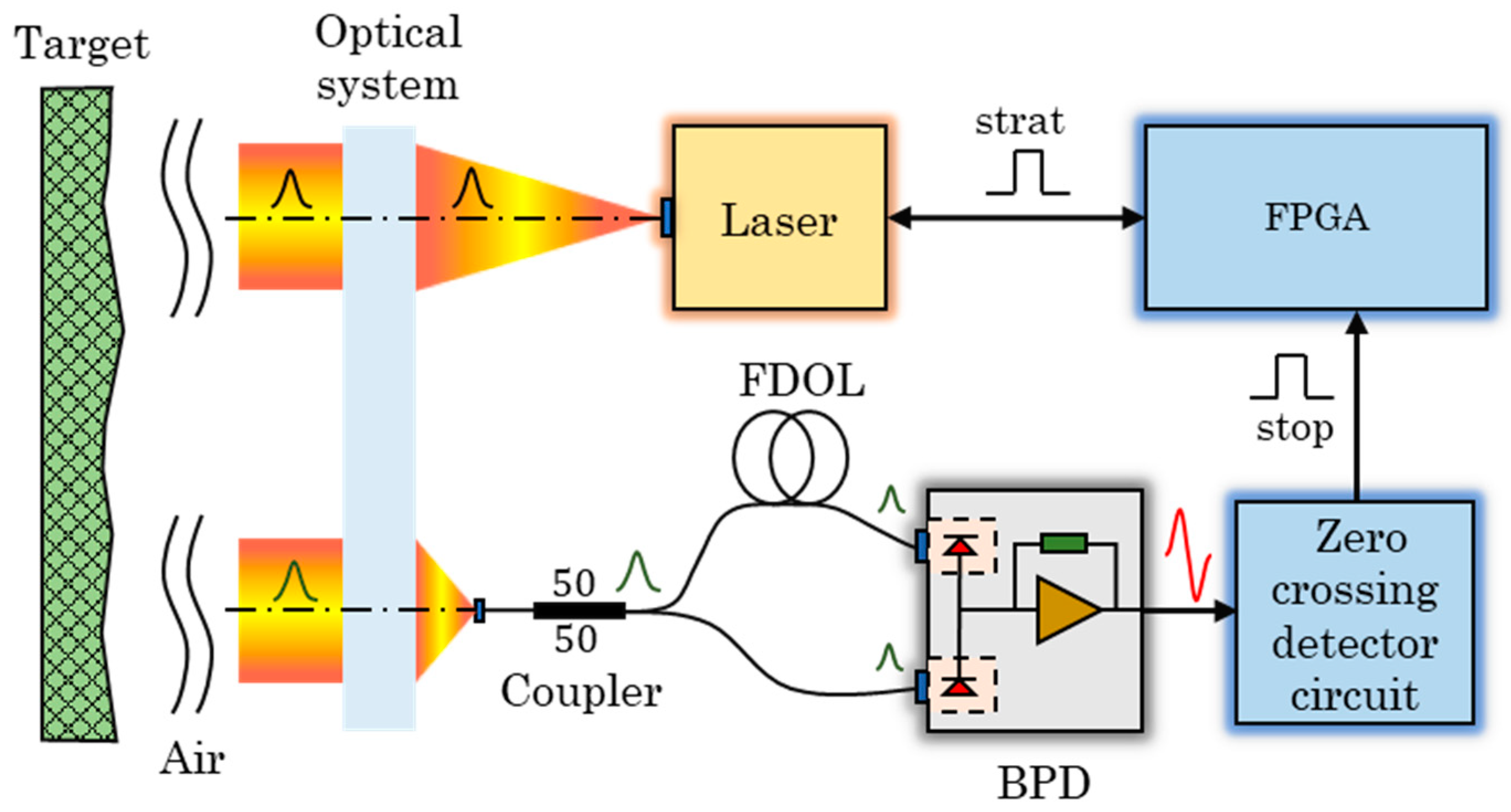
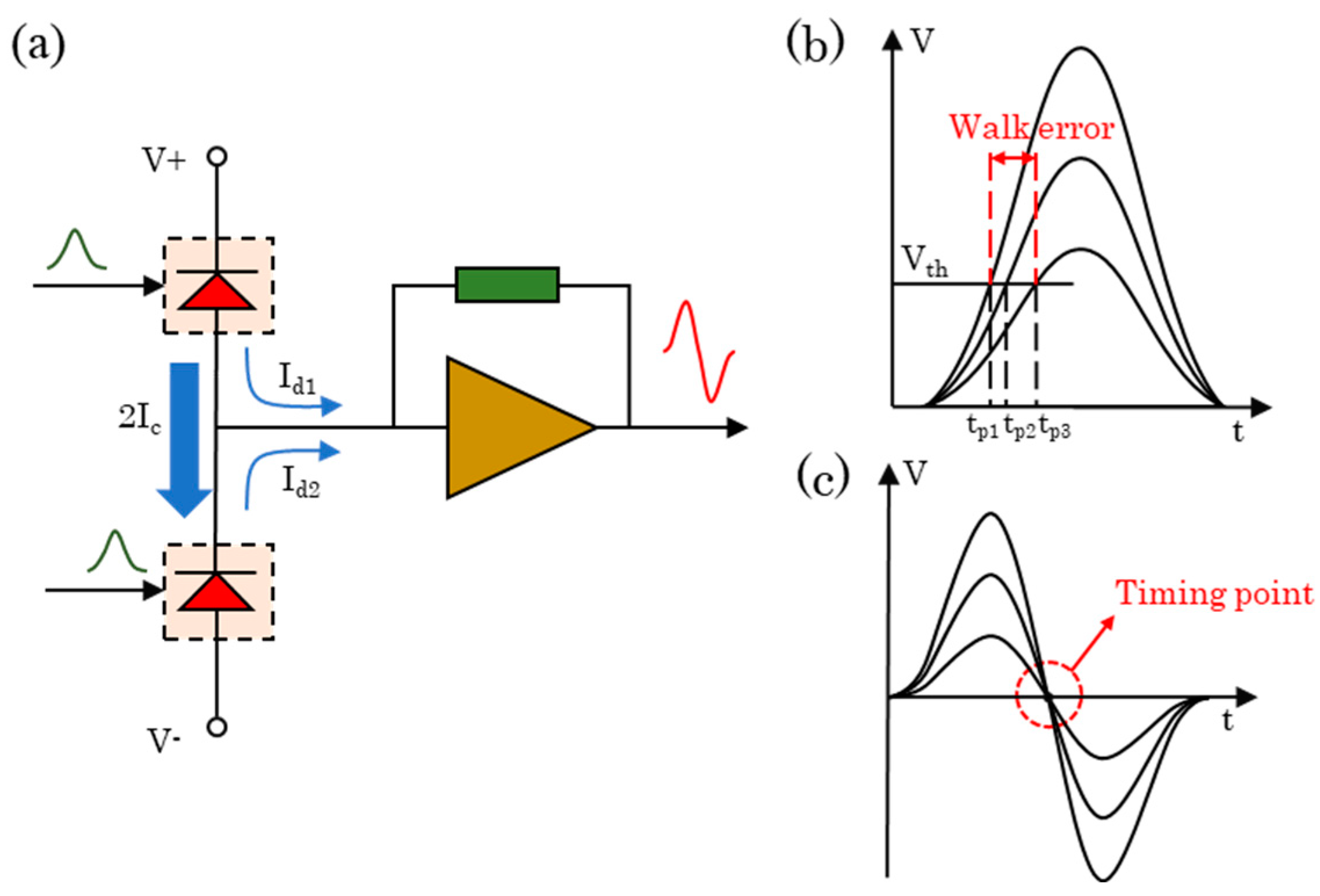
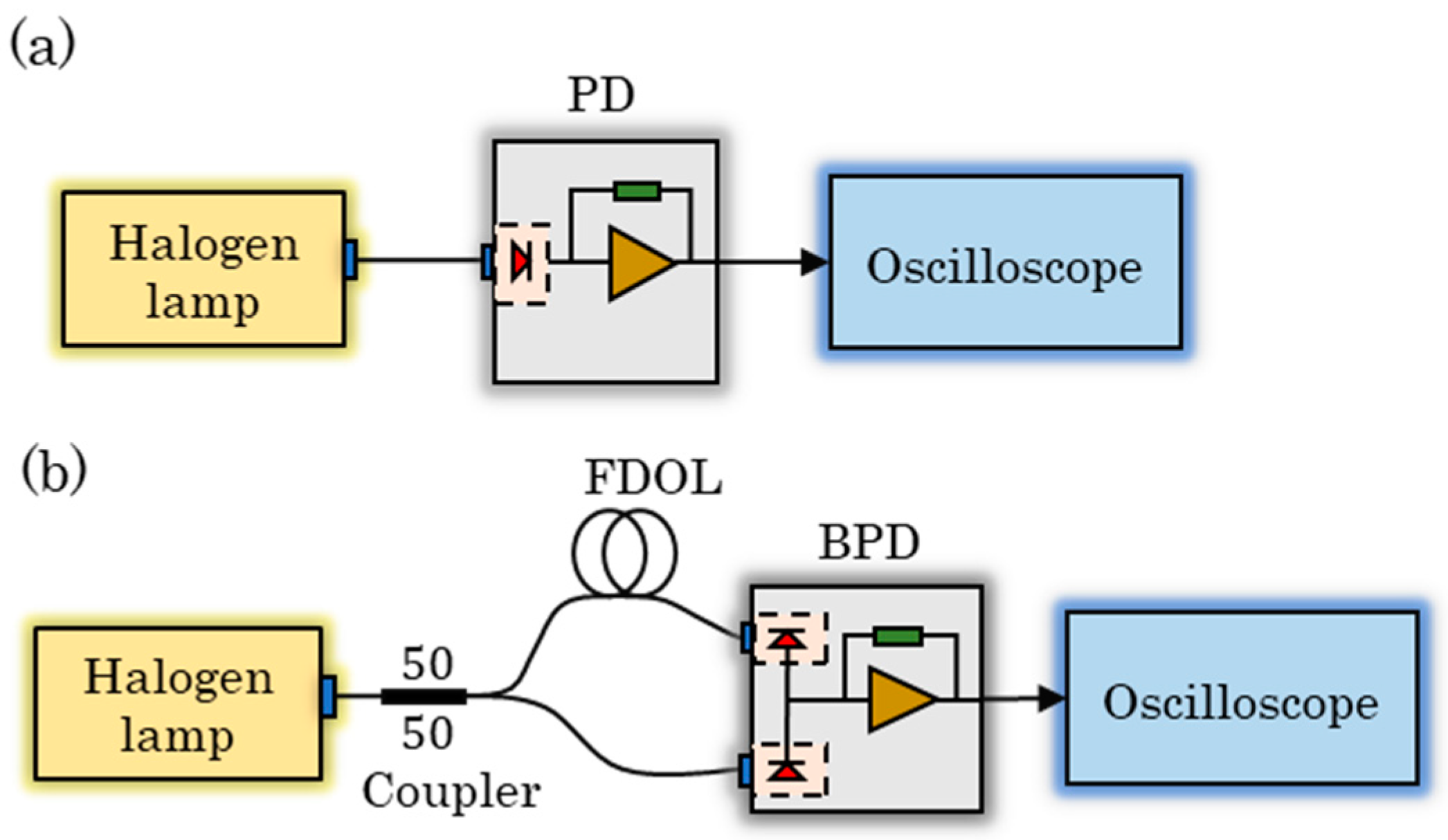
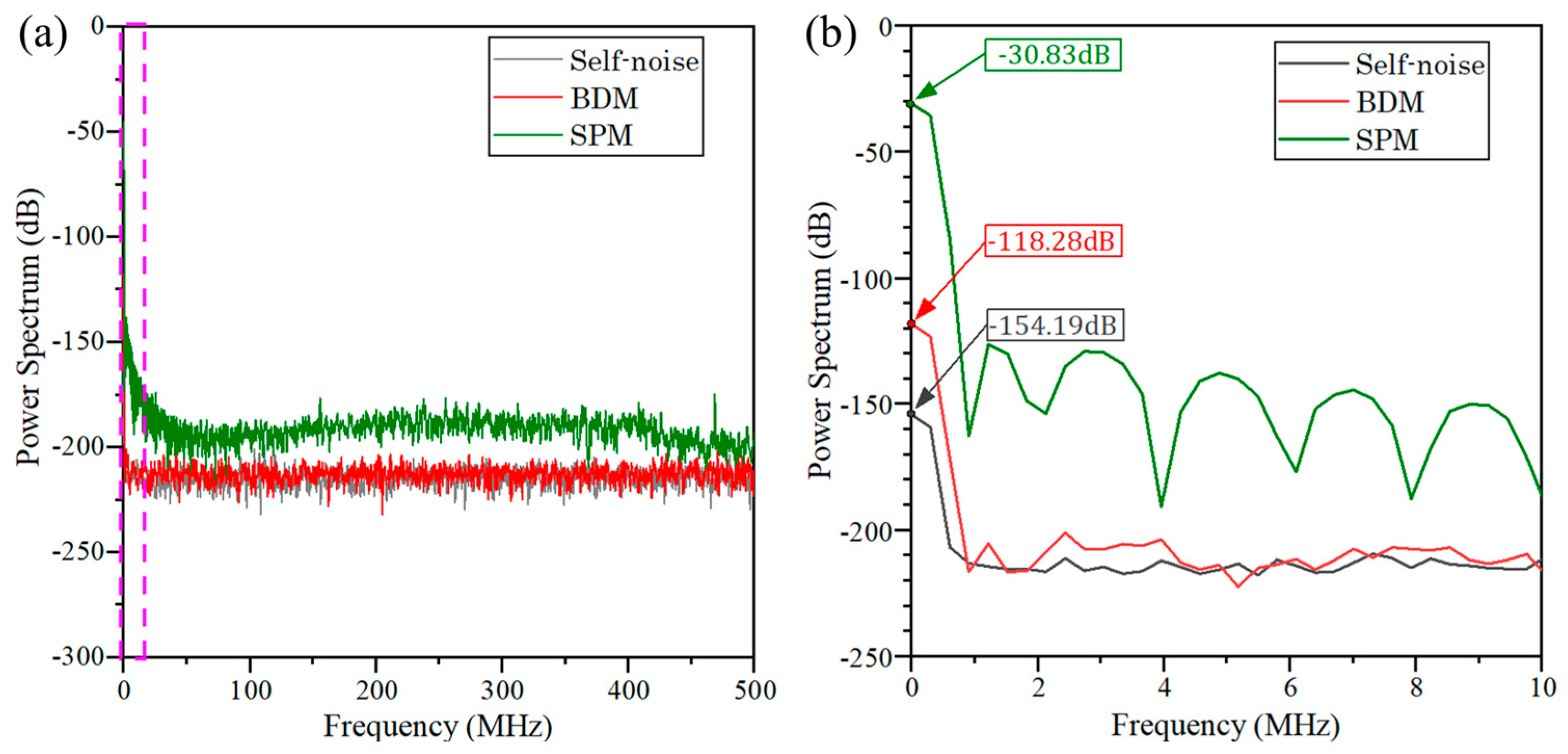

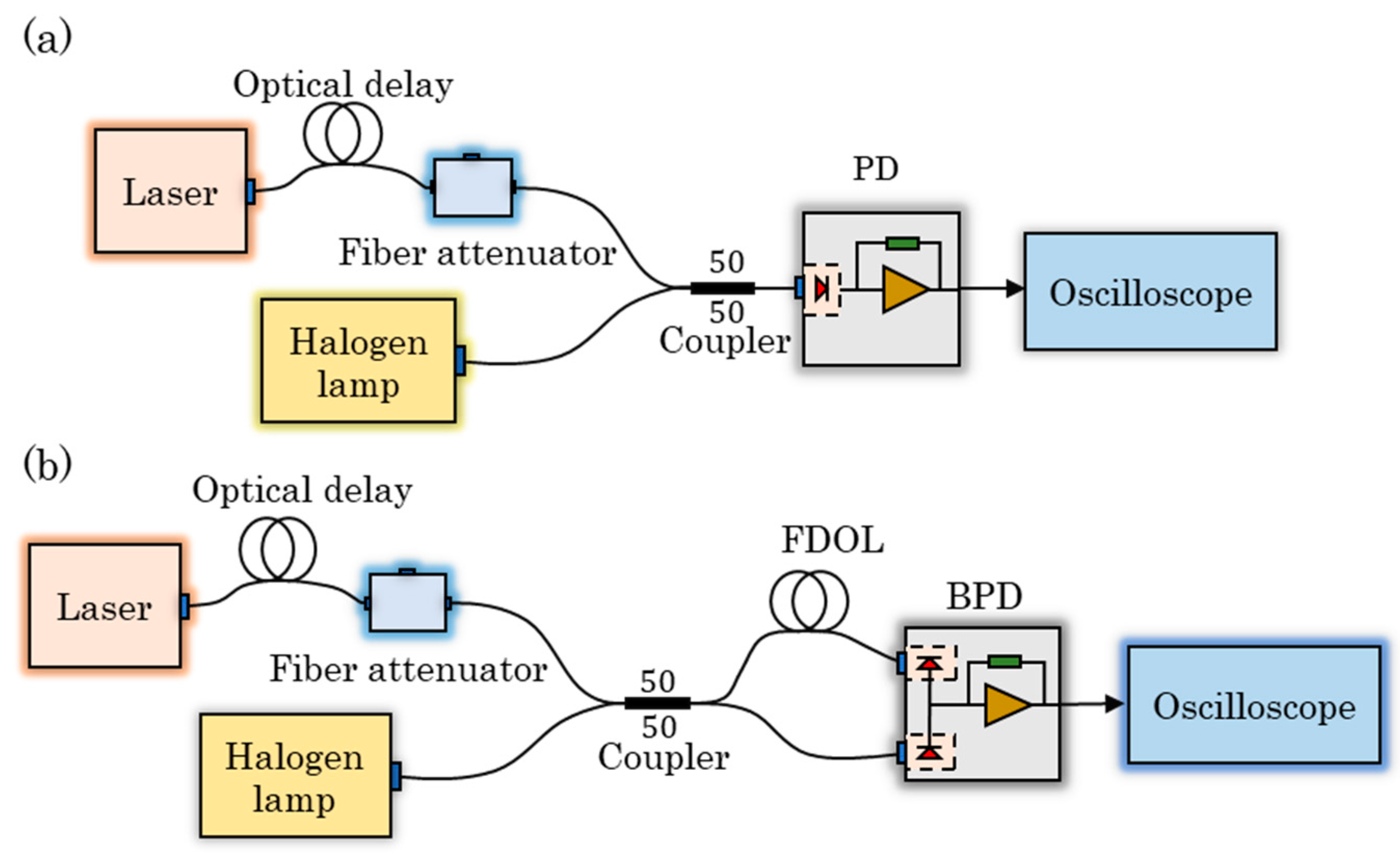



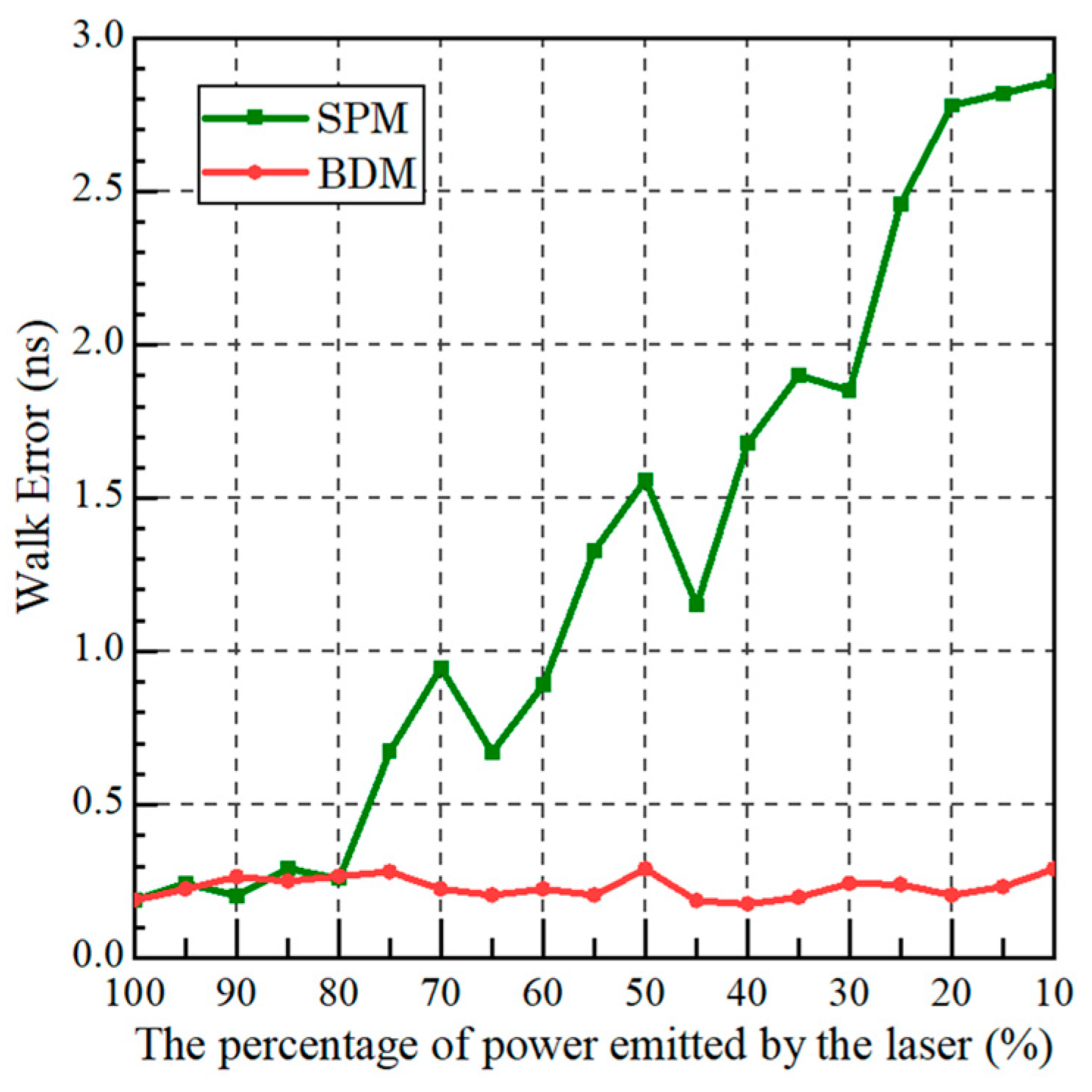
Disclaimer/Publisher’s Note: The statements, opinions and data contained in all publications are solely those of the individual author(s) and contributor(s) and not of MDPI and/or the editor(s). MDPI and/or the editor(s) disclaim responsibility for any injury to people or property resulting from any ideas, methods, instructions or products referred to in the content. |
© 2023 by the authors. Licensee MDPI, Basel, Switzerland. This article is an open access article distributed under the terms and conditions of the Creative Commons Attribution (CC BY) license (https://creativecommons.org/licenses/by/4.0/).
Share and Cite
Li, J.; Bi, Y.; Li, K.; Wu, L.; Cao, J.; Hao, Q. Improving the Accuracy of TOF LiDAR Based on Balanced Detection Method. Sensors 2023, 23, 4020. https://doi.org/10.3390/s23084020
Li J, Bi Y, Li K, Wu L, Cao J, Hao Q. Improving the Accuracy of TOF LiDAR Based on Balanced Detection Method. Sensors. 2023; 23(8):4020. https://doi.org/10.3390/s23084020
Chicago/Turabian StyleLi, Jingjing, Ying Bi, Kun Li, Lingyi Wu, Jie Cao, and Qun Hao. 2023. "Improving the Accuracy of TOF LiDAR Based on Balanced Detection Method" Sensors 23, no. 8: 4020. https://doi.org/10.3390/s23084020
APA StyleLi, J., Bi, Y., Li, K., Wu, L., Cao, J., & Hao, Q. (2023). Improving the Accuracy of TOF LiDAR Based on Balanced Detection Method. Sensors, 23(8), 4020. https://doi.org/10.3390/s23084020






